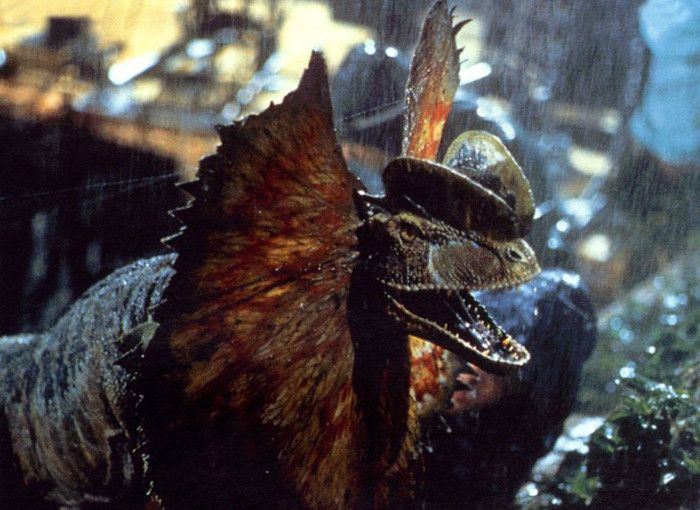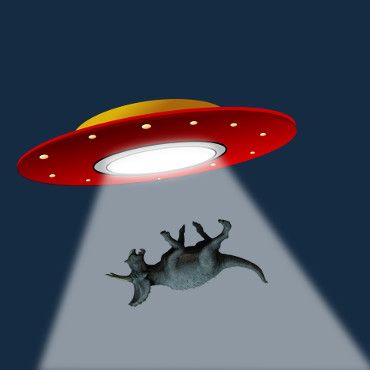
Taking The Good With The Bad
Jurassic Park rekindled the world’s romance with dinosaurs. For the first time in a long time, it was OK to like and talk about dinosaurs past the age of 12. Whether you credit the book or movie is up to you, but the franchise was overall a huge boon for dinosaur culture. Since it’s release, there have been lots of picking apart of the movie’s science, despite Steven Spielberg’s attempts to keep everything in the realm of scientific plausibility. After the dust has settled 20 years later, I think there was one dinosaur that Jurassic Park clearly wronged the worst. The poor Dilophosaurus.
How Important Are Names Anyway?
Pronouncing the name itself was the first crime. The proper name pronunciation is Die-loaf-uh-sore-us. Not Die-loff-uh-sore-us. Portraying yourself as an educational institution, Jurassic Park is supposed to be a dinosaur zoo after all, you’d expect at least an attempt at scientific accuracy. Imagine being introduced to the whole world, and having your name mispronounced. Then everyone else mispronounces it until the end of time. John Hammond should’ve spared a little more expense for his automated tour guide. You can hear the pronunciation direct from the paleontologist who discovered it, Sam Welles. The scientific dinosaur community must grate it’s teeth whenever it hears the name butchered so frequently.
No Science, Just Fiction
These aren’t things that were later discovered to be untrue. No scientists believed these following traits existed to begin with. The movie just pulls them out of thin air! First, remember the frill that pops out when the Dilophosaurus gets agitated? Yeah, that just didn’t happen. Due to the bone structure of Dilophosaurus’ vertebrae, it couldn’t have happened. Another completely made up trait was that nasty, green poisonous spit. There is no scientific evidence to support that Dilophosaurus could spit at all, poison or not. These were purely a fictional attributes added to ‘enhance’ your viewing experience. Another offense bordering on the impossible is the size of the dinosaur. Dilophosaurus was portrayed as a smallish dinosaur. Smaller than the average human in fact. In reality, Dilophosaurus was about 20 feet long. That’s pretty far from the cute little tyke you see on the big screen. You might could argue it was a baby Dilophosaurus being shown on screen, but it’s portrayed this way in all of the Jurassic franchise movies. That’s pretty consistently wrong.
Getting The Facts Right About Dilophosaurus
Since I’ve done a lot of complaining about everything that’s been faked, I figure it’s time to explain what’s real. Dilophosaurus lived 193 million years ago during the Jurassic. Its name means “two crest lizard’ for the two crests on its head. Dilophosaurus stood about 8 feet tall (2.4 meters) and was able to grasp things thanks to an opposable digit on its hands. Scientists believe Dilophosaurus was a scavenger because of a weak connection between the parts of the upper jaw that would not allow its teeth to do much stabbing. It was much more suited to plucking meat off of already dead carcasses. Yes, in the movie it attacks humans, however there are plenty of probable reasons for doing so (fear, protecting a nearby nest, etc). The original Dilophosaurus discovery was made by a Navajo in 1940, later shown to Sam Wells its discovering paleontologist in 1942. There were actually three Dilophosoaurus found at the initial site, which leads scientists to believe that they traveled in herds. Dilophosaurus skeletons have been found in the United States and China, and Dilophosaurus tracks have been found in Sweden. That wasn’t so painful, was it? Imagine what the movies could have done with that opposable digit theory?
Paleontologist Weighs In On His Dinosaur’s Slight
The Dilophosaurus in Jurassic Park shared almost nothing with its real world counterpart. Jurassic Park isn’t the only offender either. The video game ARK continues the tradition of frills, spit, and diminutive size. We marvel today at 20 foot crocodiles and alligators, so you’d think a 20 foot dinosaur would still garner a little bit of fear and respect. The discovering paleontologist actually comments on it’s appearance in Jurassic Park, as well as some of the inconsistencies from the movie. In the end, he’s pleased at it’s inclusion. It certainly put his little dinosaur on the map, so to speak. Achieving successful cloning of dinosaurs is enough science fiction for one movie, let alone an entire series of world renown blockbuster movies. We could use a little more science fact in the future to help shed more light on the real Dilophosaurus.



